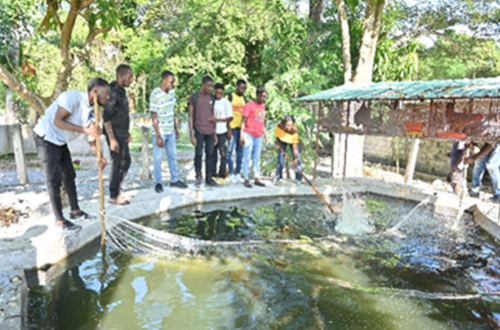April 2, 2024
Haitian Universities Rebuild Earthquake-Destroyed Fishponds to Provide Research, Extension and Revenue in Fisheries

On Saturday morning of August 14th, 2021, a magnitude 7.2 earthquake struck the Les Cayes-Aquin region of Haiti, killing more than 1,900 and leaving thousands injured and displaced from their homes. Two days later a severe storm – a tropical depression ironically called ‘Grace’ - drenched that same region in heavy rain, creating flash floods and further destruction. Research and teaching fishponds at the Les Cayes-located Universite Notre Dame d’Haiti (UNDH) and the American University of the Caribbean (AUC) were both destroyed in the onslaught and until recently they sat unrepaired and unused.
Fast forward to the spring of 2023, when agricultural activities funded under the USAID-funded project Haiti Agricultural University Partnership: Center for Mitigation, Adaptation, and Resilience to Climate-Change in Haiti (CEMARCH) begin at both of these southern sector universities. A partnership with 6 Haitian universities and Kansas State University, CEMARCH focuses on developing research and training scientists in agricultural systems in the changing climate in Haiti. Each university made the repair and re-population of their fishponds a focal point of their CEMARCH-funded Agricultural Technology Parks (ATPs), using the newly repaired and restocked ponds for their teaching and extension programs, helping to fulfill two of the key objectives of CEMARCH. Those two objectives are: the creation of programs for undergraduate/graduate education and training, and extension programs to help area farmers adapt their production techniques to the changing climate of Haiti.
At UNDH four fish ponds were refurbished in late May 2023, each with an area ranging from 580 to 620 m². These ponds were stocked with 600 Nile Tilapia (Oreochromis niloticus), with about 600 fish in each pond. Currently, UNDH is using its ponds for a student-led research project, studying the effects of food quality on fish growth and eventual yield. The work is being done by CEMARCH undergraduate scholarship students, who evaluate fish from the pond weekly to track their growth. The fish have not yet reached the recommended size for commercial sales, but once they do their sale will generate revenue for additional CEMARCH projects.
"The fish ponds at UNDH are of exceptional utility," remarked the Vice-Rector of UNDH/UDERS-Cayes, M. Pere Pierre Pascal Pierre. "They serve not only as a practical learning ground for fish farming, eliminating the need for extensive travel for this specialized course, but will also play a crucial role in boosting the overall income of UNDH", he added.
Darline Port-Louis, a Senior CEMARCH scholarship student at UNDH, shared her research success with the fish ponds. "Since last year, I embarked on my final year thesis focusing on the advantages of freshwater fish farming. The previous approach involved significant financial investment in traveling to locations with existing fish ponds. However, with the introduction of these ponds at UNDH, the need for extensive travel has been eliminated. This not only enhances the convenience of my research but also allows me to contribute actively to UNDH by exploring cost-effective fish feed solutions, ultimately ensuring a more financially viable and beneficial approach to fish farming."
If UNDH is just getting started with its’ ponds, AUC is an example of a program that is farther along in the study, production, and sale of fish. Renovated in 2023, the fishpond at AUC is 30 square meters in size, and it has been restocked with Red Tilapia. The pond is being used for teaching, and to produce fingerling fish for sale. The current feed source for the Tilapia is chicken manure, from chickens that are part of another CEMARCH project. The fertile water overflows from the pond is being used to irrigate and provide nutrition to a rice paddy located on the ATP. In 2024, three more ponds will be built for a wider range of feeding trials, allowing AUC to expand their teaching and research facility. In addition to the sale of fingerlings harvested fish will be processed, stored in the AUC freezer facility, and sold from the CEMARCH market sale counter that was opened in 2023, with sales beginning in March, 2024.
Diamson Charles, the ATP manager at AUC, says: ‘I would never believe we could produce so many fish in just six months, starting with only 150 fingerlings. Constructing more fishponds will allow us to increase and diversify our stock, and also to earn more money through sales of fishes and fingerlings.’ The fishponds are also an important teaching tool, as noted by Phara Melissa Esperance, a Sophomore CEMARCH scholar student from the College of Agriculture and Environmental Science at AUC. She says: ‘What amazes me the most about this pond is that the fish obtain their nutrients solely from the chicken manure coming out of the cage located right on the top of the pond. I would never believe that can happen. In addition, nothing is lost, as even the fertile water overflow coming out from the pond is used to feed the nearby rice plot”.
The CEMARCH universities are investing in research projects in fish pond management because fish ponds represent a reachable and practical way for Haitian farmers to produce and provide affordable protein to Haitians. Typical Haitian diets often solely consist of rice and other starchy staples, and nutrient-dense foods may be missing. Farmed pond-raised fish can help to fill this diet gap, and may be able to do so affordably if the limitations of construction cost and feed costs can be overcome. The pond fisheries research being performed at AUC and UNDH will help farmers determine best practices for fish production, and aid in feed selection.
Additionally, as is being done with the research with AUC, water from the pond can be used in hydroponic facilities, providing nutrient-dense water for producing vegetables in a controlled environment. These fish ponds, supported with CEMARCH funding, will continue to support research and extension efforts in agricultural systems, providing innovative and sustainable solutions for the farmers of Haiti.